 |
 |
 |
 |
 |
 |
 |
 |
 |
 |
 |
 |
 |
 |
 |
 |
 |
|
 |
 |
 |
|
 |
 |
 |
|
 |
 |
 |
Grateful thanks to all those that have provided many of the articles, references and details in these pages
This is a non-profit site |
| |
| |
| |
| |
| |
| |
| |
|
 |
William Gravatt 1806 - 1866
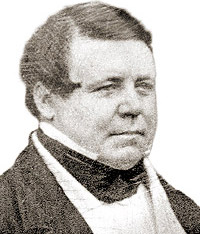 |
|
 |
 |
Mr William Gravatt
Courtesy Institution of Civil Engineers |
|
 |
 |
|
Gravatt, a gentle giant, was a well respected civil engineer.
Superintended projects for both Marc and Isembard Brunel; especially remembered for the part he played in the construction of the Thames Tunnel Crossing.
 Resident engineer on the Bristol & Exeter Railway. Resident engineer on the Bristol & Exeter Railway.
He designed the 'Dumpy', a simplified theodolite which is still used today.
 |
|
|
William Gravatt was born in Gravesend in Kent on 14th July 1806. His father, a well-to-do Colonel of the Royal Engineers at Woolwich, was not a man to give his children an easy ride through life. He instilled in them the belief that they should look after themselves. In a letter of introduction for young Gravatt to work as an apprentice, his father, nevertheless proud of his son, wrote to his prospective employer, Mr Bryan Donkin, "My son has been brought up to know that he must trust to his own resources for advancement in life. Throwing as far as I can from me the partiality of a father, I must yet be permitted to say that his habits are peculiarly suited for the attainment of the duties of your noble profession, since, to a good classical education he joins a knowledge of mathematics seldom attained at his years, including the practical parts of perspective, and the drawing of plans, elevations, and sections; he has also a most determined bias to whatever relates to machinery, which last I attribute to his having made the steam and other engines in this arsenal the objects of his contemplation".
It was during his years as an apprentice, that he met with a number of well respected engineers - Mr Troughton, Dr Wollaston and John Smeaton. His friendship with Troughton and Wollaston would last until their deaths.
back to top of page >>
Thames Tunnel Crossing
Before serving his full apprenticeship with Mr Donkin, he gained employment with Isembard Kingdom Brunel who, "considered that he was a competent person to attend to the management of ‘the shield,'* in particular, and, in general, to the machinery belonging to the Thames Tunnel." He was extremely diligent, frequently remaining in the tunnel all night. On more than one occasion, when Brunel was incapacitated by sickness, he stayed on duty for "thirty-eight hours", spending those needed for much earned sleep, at the bedside of his friend, Brunel.
|
 |
|
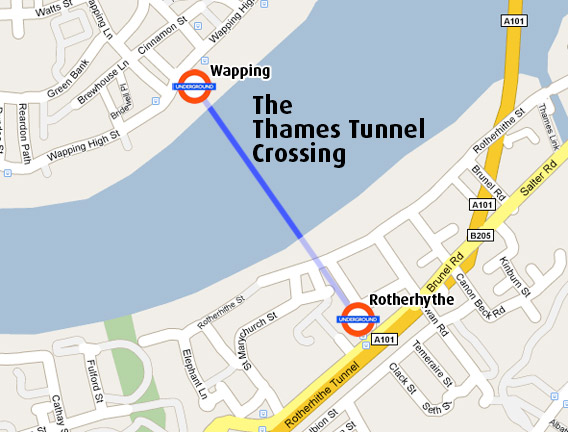 |
 |
The route of the Thames Tunnel Crossing.
courtesy Greg Smye-Rumsby
 |
Unfortunately, the river water of the Thames broke through the work front, inundating the tunnel with water. On those occasions the tunnel was an extremely dangerous place. On 27 June 1827, after an inundation of the river, two of the Directors, Robert Marten and Richard Harris insisted Gravatt take them down the tunnel although Brunel had forbidden any other journeys. Gravatt could hardly defy his directors. He requested the help of two of the miners, Richardson and Dowling as crew for a dinghy. Richardson insisted on sitting in the stern of the boat. Water started coming into the boat, so one of the directors was asked to move forward to balance the vessel. Neither was willing to move but when the water became uncomfortable, Mr Marten made to move forward. However, he had forgotten that the boat had made considerable progress down the Tunnel, and when he stood up, he struck his head on the roof and fell backwards. The boat overturned depositing all the occupants into twelve feet of water. Gravatt and Dowling were the only people who could swim. One of the directors clung tightly to Gravatt, preventing him from breathing. So Gravatt was forced to dive in order to free himself. Gravatt swam back to the shaft and quickly returned with the punt. After rescuing Marten and Harris, Richardson was still missing. Brunel who had been alerted to the accident appeared on the scene and dived several times in search of Richardson, but in vain. After some time, officials from the Humane Society arrived and recovered the body with a drag-line.
"On the 5th of March, 1828, silver medals were voted by the Royal Humane Society to Mr. I.K. Brunel and Mr. William Gravatt for having hazarded their own lives to preserve those of their fellow-creatures." Isambard was also presented with a gold ring, as "A memorial of the events of the 27th of June, 1827, and of his humane, prompt, and efficient help in rescuing them from a perilous situation".
In 1832 Gravatt became both a Fellow of the Royal Society and the Royal Astronomical Society, and in the proceedings of both Societies he took an active interest.
Work on the Thames Tunnel was frequently halted due to sudden and unexpected flooding. In 1832, the project was completed stopped.
At this time, Gravatt was, by the recommendation of his previous employer, Mr. Donkin, appointed Engineer to the Calder and Hebble Navigation. It was here that he commenced his first works, in the form of several river bridges, the arches of which were remarkable for their stability and cost effectiveness. The principles he adopted for their construction was the forerunner of the suspension bridge.
 |
 |
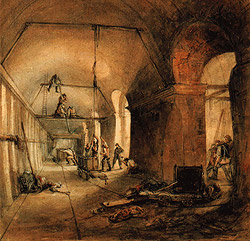 |
|
 |
 |
The Thames Tunnel during construction
Courtesy Liverpool John Moores University |
|
 |
 |
Gravatt's bridges were well received, utilising a system, "in which the suspending chain, instead of being flexible, is formed of plate iron, so as to possess in the requisite degree the rigidity of a plate or box-girder. The platform of the roadway was laid throughout, on the back of a pair of arched girders, each of which consisted of several layers of timber bolted together, with hard wood keys interposed between the contiguous layers buried half in each, near the bolts, so as to prevent the surfaces from sliding, when pressure had to be obliquely transmitted from layer to layer."
Gravatt was commissioned by Mr. H. R. Palmer in examining the country for the original scheme of the London and Dover Railway. During the early period of railway construction he devised a level known as the ‘dumpy' and also the ‘level-staff' which is now universally employed, but which is not generally known to have been introduced by him.
He also designed a pocket-sized instrument, which he called a ‘nadir'. By using both the ‘nadir' and a common box-sextant, it was possible to carry out surveys single handedly in areas where the lie of the land was prohibitively difficult or where the landowner may have had some opposition.
back to top of page >>
Hard Times
 |
 |
 |
|
 |
 |
Not one one of Gravatt's greatest engineering successes. In 1840 he was given a very free hand in the design of the Parrett bridge shown above. Incorporating a very flat brick arch, it began to sink soon after opening and had to be rebuilt. Above are the remains of the old bridge over the river Parrett near Westover Farm, about half a mile west of Muchelney. This view looking towards Thorney.
|
|
 |
 |
In 1834, he was employed by Mr. Brunel to survey a railway line from Cardiff to Merthyr Tudfil and Dowlais. He was also engaged in designing several bridges for the Great Western Railway. A year later, Mr. Brunel requested his help as superintendent of the parliamentary surveys, to trace the line for the Bristol and Exeter Railway. This particular task exhibited Gravatt's extraordinary and well-known powers of endurance. The work, undertaken over a month, extended over 75 miles! Today, the railway runs along the same lines as surveyed, not deviating from the original drawings by more than "10 yards", testimony to Gravatt's efficiency and accuracy. It was during this survey, as "Engineer to the canalization of the River Parret to Langport", he constructed a stone bridge there. While at Bristol, he designed and superintended the erection of the St. Philip's drawbridge.
During the railway mania of 1845-6, Mr. Gravatt was caught out financially, having undertaken several surveys which neither led to construction or his own remuneration for his work. This affected him greatly.
The Craig Telescope
In 1850 he was, on account of his well-known mathematical and mechanical acquirements, selected to design and to superintend the construction of an Achromatic Telescope.
Gravatt was clearly a liked man. During his residency in London he had made some kind of connection with Richard Beard, the victorian portrait photographer. They had both lived at 34 Parliament Street. It is quite probable that Beard had been told specific information about the Craig Telescope in Wandsworth, so that when Beard came to photograph it in 1852 for the Illustrated London News, he would already have been predisposed to all the idiosyncrasies of the instrument, portraying it from its best side. If the telescope had not yet been completed, then it was easier for Beard to have known what else needed to be added or modified, assisting the engraver who had been commissioned by the publication to created the telescope's likeness.
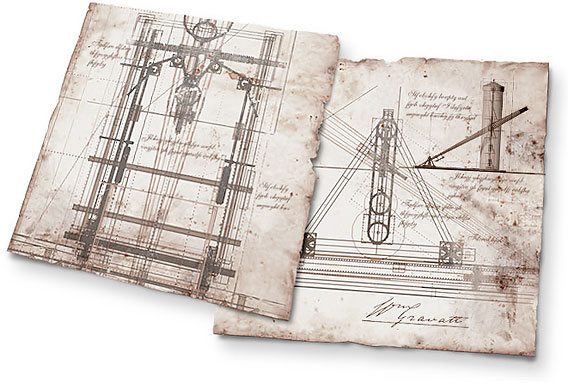 |
 |
Gravatt would have submitted plans not only to Craig but also to 4th Earl Spencer who would have been keen to see exactly what the telescope was to look like. Sadly there there are no signs of these plans today, above is just a facsimile of how they may have appeared.
courtesy Greg Smye-Rumsby
 |
When M. Scheutz, in 1854, brought his ‘difference engine' to London, Mr. Gravatt at once took up a subject which had long interested him, and he soon mastered the difficulties of that ingenious machine. In 1855 he undertook the task of explaining to Prince Albert and to the Fellows of the Royal Society its principle and mode of action, and when it was placed in the International Exposition at Paris he continued to illustrate its construction and action; in fact, "Without him" says Mr. Babbage, "we should have had no calculating machine." The instrument, therefore, which was constructed by Messrs. Donkin after the Swedish original, and which is now worked at Somerset House under the direction of the Registrar-General, is due to Mr. Gravatt. Under his direction, specimens of logarithmic and other tables were calculated and printed without the use of types, thereby establishing the faith of the public in its capability of not only performing but also of registering complicated calculations.
 |
 |
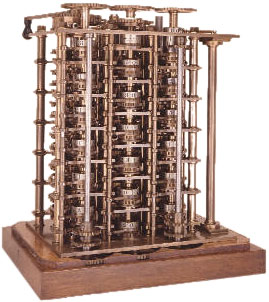 |
|
 |
 |
A fragment of the Difference Engine No. 1 (1832). This is a small part of Difference Engine No. 1 and the only major part that was constructed during Babbage's lifetime. It is housed in the Science Museum, London and is still in perfect working order.
© Science Museum, London. Science & Society Picture Library
|
|
 |
 |
He likewise calculated, stereoglyphed, and printed without the use of types, some mountain barometric tables, which in the form of a brochure, were circulated among his friends.[1b] Amongst the educated classes of the Chinese, who avoid politics, a taste for the mathematical sciences is very prevalent. The numerous translations of western scientific works attest this fact, and among their reproductions is the reprint by them of Gravatt's "Companion to the Mountain Barometer." For his services rendered to science, in connection with the Swedish difference engine, he was elected Foreign Member of the Royal Academy of Sweden.
back to top of page >>
Mr. Gravatt joined the Institution of Civil Engineers as an Associate in 1826, and in 1828 he was transferred to the class of Members. He was a constant attendant at the meetings, frequently taking part in the discussions, especially on the occasion of novel, or abstruse questions. He gook a prominent part in the discussion on the theory of the jet-propeller, and on the submerging of telegraphic cables.
It is always difficult to put, in an acceptable shape, before an assembly of practical men, a purely mathematical exposition of the fundamental dynamic conditions which underlie the solution of a practical problem; especially when, on the one hand, the elucidation involves intricate and abstract modes of thought, and when, on the other, the theoretical conclusions drawn therefrom must, in their application to practice, be largely modified by obvious, though collateral practical conditions. Now, Mr. Gravatt's manner in discussion, though convincing in private, was no such in public as to master this difficulty so as to do justice to his matter. It was perhaps attributable to these circumstances that. in the controversy which followed the reading of Mr. D.K. Clark's Paper in 1854 on "Ruthven's Propeller," his view was warmly opposed by several eminent members of the Institution. Nevertheless, the view itself, exhibited in succinct and masterly mathematical language, is (regarded in a purely dynamical light, and taking account of its entire fundamental dynamic conditions) a true solution of the question at that time at issue. If by the labours of more recent investigators, like Dr. Rankine and Mr. Froude, this solution has, on the practical side, been extended, Mr. Gravatt's, so far as it went, not only remains uncontroverted, but has received unqualified confirmation. It is to be found among the pamphlets in the library of the Institution, in "A Letter on Steam Gun-boats of shallow draught and high speed."
His view of the mathematic-mechanics of laying submarine cables was clear and profound, and in himself wholly original; but not absolutely, with regard to others who preceded him in laying down the theory. At the termination of the controversy which took place between himself and the Astronomer-Royal, the latter said, - "Though I partly disagree, I do in great measure agree with you, and am rather surprised that with so little calculation you should have arrived at results of such general accuracy." Mr. Gravatt published in the "Philosophical Magazine" of July, 1858, a further elucidation of the conclusions at which he arrived during the discussion on Messrs. Longridge and Brooks' Paper at the Institution in February, 1858.
Mr. Gravatt was, in the strictest sense, a remarkable man; peculiar to a degree which may fairly be called extraordinary, even in his defects, especially in those usually associated with want of sense, and implying that want; combined, however, with the possession on most points of the most solid and widely ranging perception and judgment - "common sense," in the strictest meaning of the term. He was like one of those wonderful pieces of work of his friend Troughton, which, for some small blemish or defect, its maker consigned to the limbo of the brass-box to be sold some day as old metal, although fit for all but the most perfect performance of the work for which it had been intended.
Capable of the warmest and most persistent friendship, Mr. Gravatt was also susceptible of strong resentment. This was, for the most part, based on a perception of wrong, as such, and expressed his strong and clear disapprobation of wrong doing. It was also sometimes tinged with personal feelings, and warped by the operation of one or other of those disturbing mental forces which have already been alluded to; and, as a natural consequence, it was at such times often unjust. But if ever he came to see, as he was never unwilling to do, if proof came before him, that he had been induced into error, he was, in a manner unequivocally hearty, most forward to apologize. In fact, he was chivalrously honorable in all his feelings and transactions, and he never hesitated to admit that he had been in error. The art of engineering men, such as the superior workmen at the Thames Tunnel, he possessed in an eminent degree, and had he been endowed with the same faculty, when he was brought into contact with men in general and with directors of public companies in particular, he would have attained success in life, in proportion to his capacity in engineering matters.
Of all the gifts presented to Mr. Gravatt, a pair of calipers made by Troughton's own hands, Bryan Donkin's chronometer by Hardy, and a specimen of Babbage's original difference engine, were those which he regarded with the sincerest pleasure. These tokens consoled him when, finding himself passed in the race of life by men who did not possess his qualifications, he was led to the inference that they did so, not because they were sounder mechanics than he, but because they were more men of the world.
back to top of page >>
It would be very difficult to discuss, in a form suitable for the succinct Memoirs of the Institution, even a portion of the works upon which Mr. Gravatt was engaged. They were remarkable, not for their number, or for their magnitude, in the ordinary sense of that term, but for the amount of refined professional skill; and, if the word may be used, for the ‘affectionate" scientific elaboration which they embodied. Some of the boldest and best contrived of his works, the great telescope, and the bridge over the River Parret, near Bridgewater, for instance, have not, in fact, survived.
The best memorial of his broad and deep professional knowledge, his varied acquirements, his versatile and kindly humour, would be a record of his table-talk, especially of such portions of it as belonged to the occasions when, in the company of various congenial friends, who, he felt, could appreciate and follow the current record which exists is that which survives in the recollections of his friends. And such recollections, however intimate the friendship and congenial the temper of those who are their depositaries, are at best but ineffective substitutes for the portraiture which short-hand notes alone could adequately supply.
It would perhaps seem disproportionate, and perhaps unwarranted to say, that but for Plato the wisdom of Socrates would have been lost. Certainly, but for the indefatigable and almost unexampled labours of Boswell, we should scarcely have half known Johnson. And there undoubtedly have been men of great capacity and varied acquirements, who have possessed, besides great power of communicating their ideas in familiar conversation, whose gifts and whose accomplishments, thought they have exerted a wide and deep influence on the current of contemporary thought, have yet left few permanent marks associated with their name and with their history, - "carent quia vate sacro."
Mr. Gravatt undoubtedly was one of these; and though many Engineers of the present day recollect, with more or less distinctness, how largely their stores of professional knowledge have been stocked from his warehouse; how greatly their forms of thought and methods of investigation have been influenced by his views, they could but poorly convey to others an inheritance which they feel to have been of life-long value to themselves.
Accidental Poisoning
The career of Mr. Gravatt was brought to an untimely end at Westminster, on the 30th May, 1866, under very painful circumstances. He was "poisoned by an overdose of morphia given inadverently by his nurse," - a faithful and attached servant, to whom, in the jury's opinion, "sufficient caution was not given by the medical man in attendance."
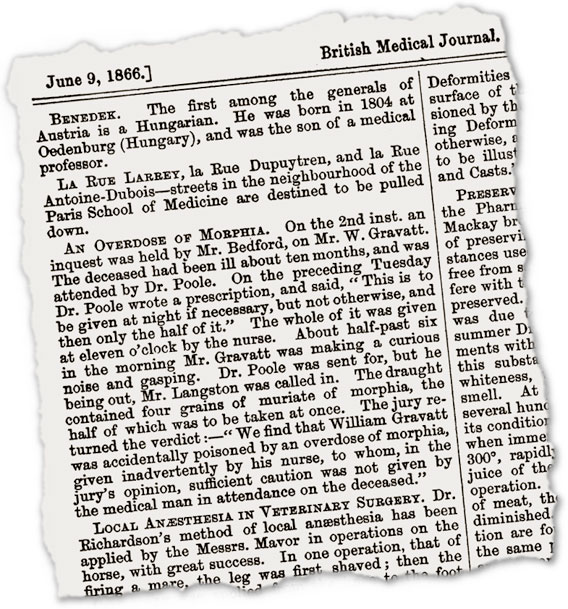
There was in Mr. Gravatt all the material to make an engineer; he possessed great acquirements, succeeded in almost everything that he undertook, was full of high, chivalrous and honorable feelings, he had a kind heart and generous mind; and he ought to have taken a very high position in his profession; but in this he failed because he could not, or would not, conform to the ordinary ways of the men among whom his lot was cast.
back to top of page >>
|
 |
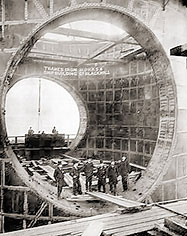 |
 |
Part of the huge fabrication called 'the shield' needed for the Thames Tunnel, third from right is Isembard Brunel, second from right is William Gravatt
Courtesy Liverpool John Moores University
|
 |
Gravatt was clearly a liked man. During his residency in London he had made some kind of connection with Richard Beard, the victorian portrait photographer. At one time they were both living in apartments of a large residency at 34 Parliament Street.

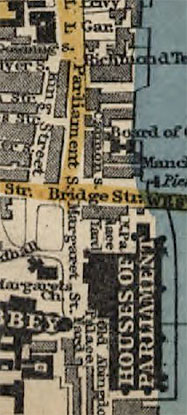

Courtesy
It is quite probable that Beard had been told specific information about the Craig Telescope, so that when he came to photograph it in 1852 for the Illustrated London News, he would already have been predisposed to all the idiosyncrasies of the instrument, portraying it from its best side. If the telescope had not yet been completed, then it was easier for Beard to have known what else needed to be added or modified, assisting the engraver who had been commissioned by the publication to created the telescope's likeness. |
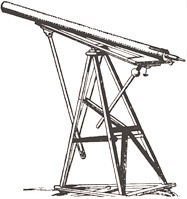 |
 |
An illustration from John Weale's The Pictorial Handbook of London 1854, showing what appears to be a large 7 1/2-inch refractor figured by Newman of York and mounted temporarily on an altaz mounting.
Under the title The Observatory of Rev J B Reade FRAS at Stone Vicarage pp692-693, there is this quote, "This fine instrument [the equatorial] is at present mounted on a Varley's stand, to which Mr Reade has added some very convenient adjustments for its motion, in both in altitude and azimuth; but ere long it will be placed in the tower of the observatory, on a very firm equatorial mounting, made by the village carpenter, Mr Carter, under the superintendence of Mr Gravatt, the iron-work &c., being prepared by Mr Donkin."
It seems that although the telescope may not have been finished, Gravatt was clearly engaged in supervising this telescope's construction. The date would suggest that Gravatt was unperturbed by the events at Wandsworth and that he was still focused on the construction of telescopes generally.
Courtesy Google Books |
 |
|
|

